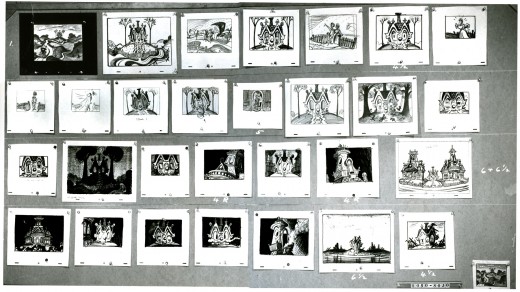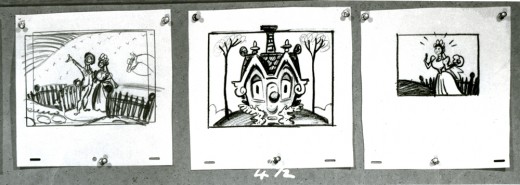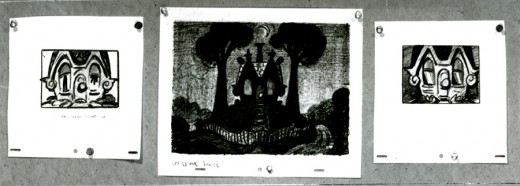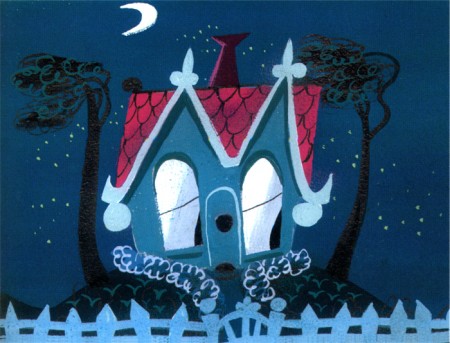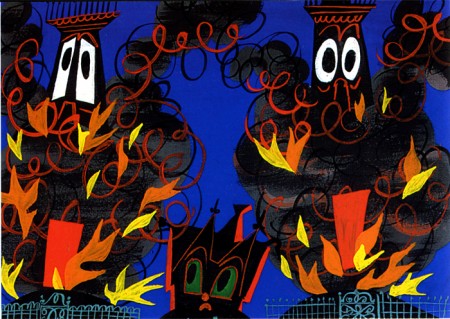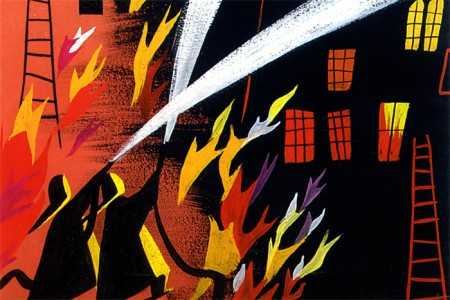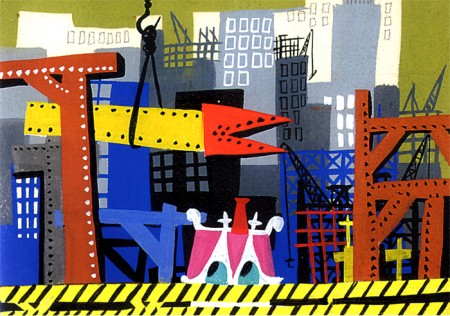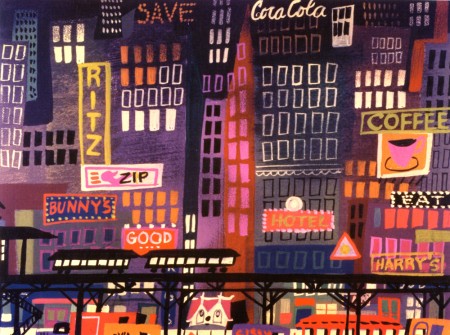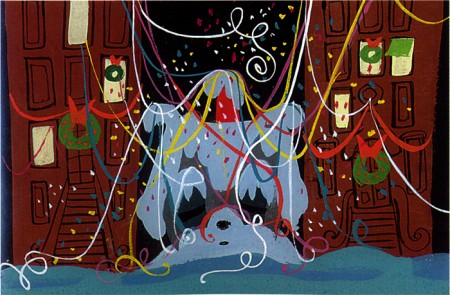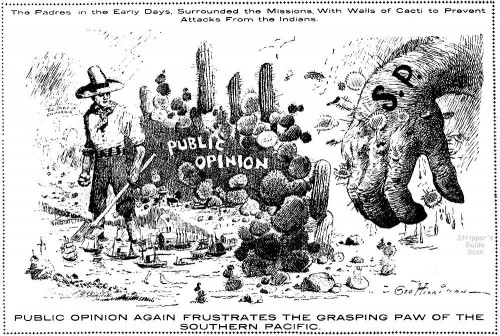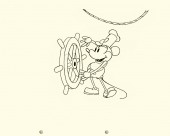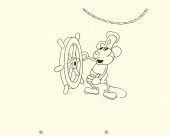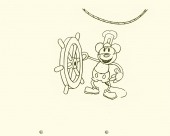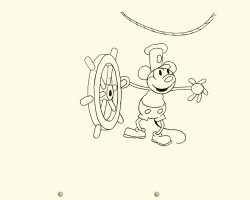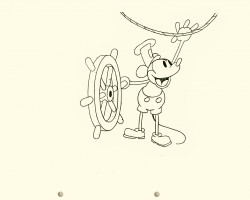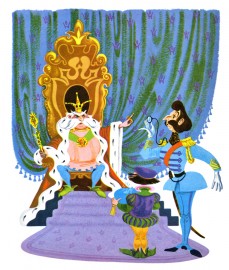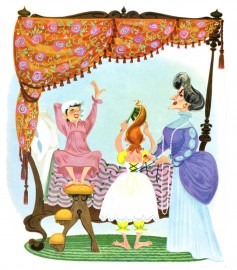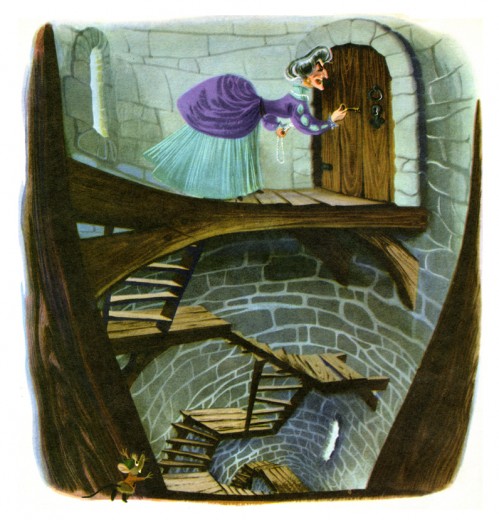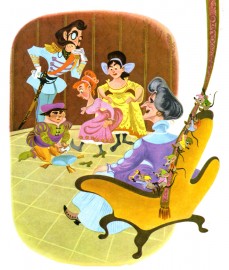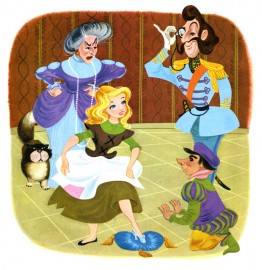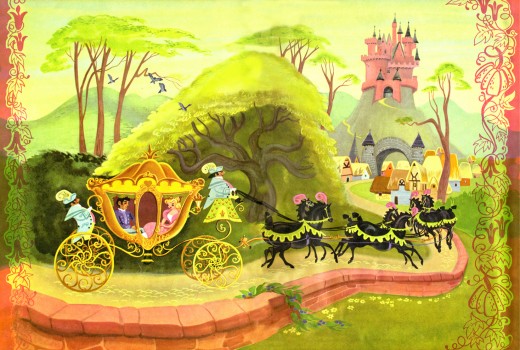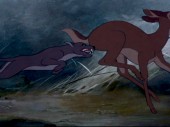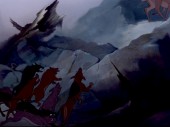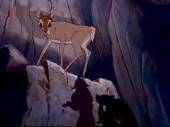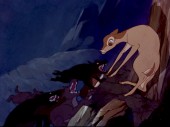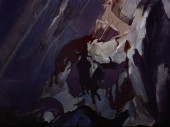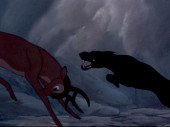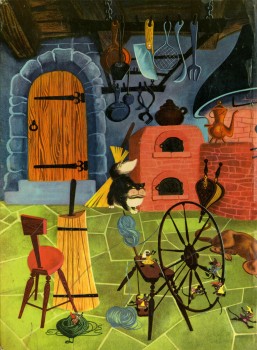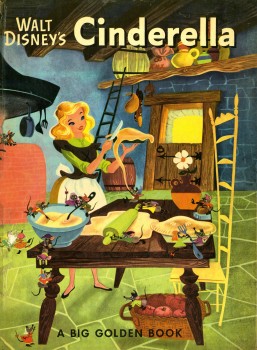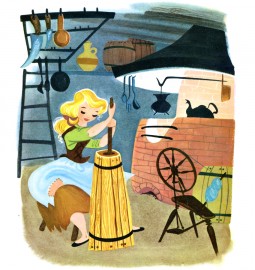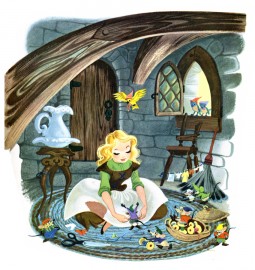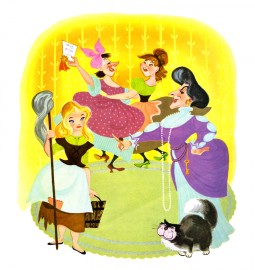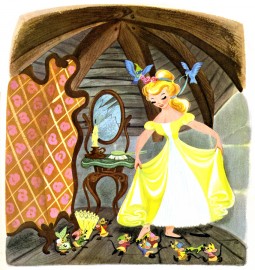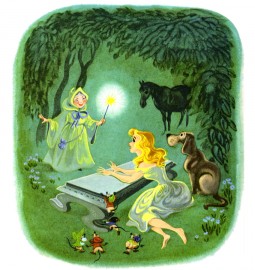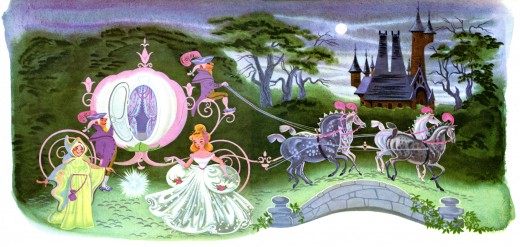Category ArchiveMary Blair
Animation Artifacts &Books &Disney &Illustration &Mary Blair &Peet &Story & Storyboards 21 Jan 2008 09:35 am
Peet and Blair’s Little House
- Earlier this week, I posted John Canemaker ‘s loan of a couple of storyboards by Bill Peet from Bill Cottrell’s script for The Little House. This was adapted from the children’s book by Virgina Lee Burton.
Today I’ve got a fifth board. I’m not sure it’s storyboard; the images look a bit more like background layouts. Perhaps it’s something in between the two. I’m not even sure the drawings are by Bill Peet.
This is the actual board. However, I’m posting it as I did the others in pieces so that it can best be enlarged for good viewing.
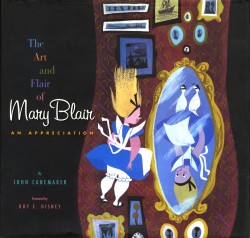
_
- Mary Blair was the dominating design force on this film, and her work stands out vigorously.
John’s exceptional book, The Art and Flair of Mary Blair includes a number of key pieces of art for this short. I think it might be remiss for me not to post them alongside these storyboards to see how Peet and Blair worked together. With thanks and apologies to John and his excellent book, here are the color scans.
_
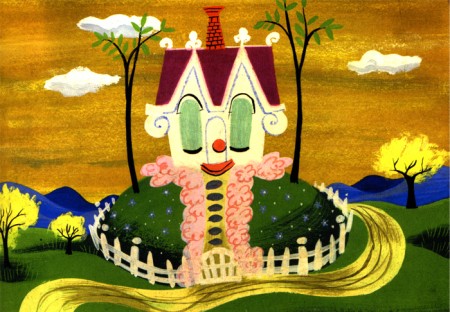
(Click any image to enlarge.)
Animation Artifacts &Disney &Mary Blair &Story & Storyboards 15 Jan 2008 09:11 am
Peet’s Little House 2
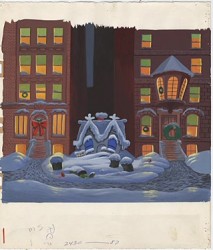 - Here’s the second of five storyboard pages loaned me by John Canemaker. The boards were drawn by the brilliant Bill Peet.
- Here’s the second of five storyboard pages loaned me by John Canemaker. The boards were drawn by the brilliant Bill Peet.
The Little House was a short, and is part of the Disney Rarities dvd still available. The image to the right comes from that dvd’s extras.
Mary Blair was the key designer of the film. Her color work is exceptional, and I’ll try to give some examples of her art in future posts.
All of these boards are small photos that I’m blowing up large, so you’ll be able to see them. It involves heavy scanning of oversize work, then cutting them up and reconstructing them so that they’re in order. Sorry that I have to take a few posts to make them all available. They’re worth the trouble.______________ (Click images to enlarge them.)
Here’s the second page of this board.
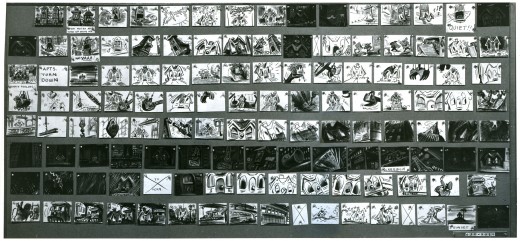
This is the full second board as it looks before I cut it apart. You can see that the image is small and I had to cut it up so you can enlarge it enough to make it visible.
The blue nunbers below the panels represent the row of images displayed.
Daily post &Mary Blair 10 Sep 2007 07:55 am
Bits ‘n’ Pieces
A new blog hits the streets this morning. David Levy, the President of ASIFA-East and the author of Your Career in Animation: How to Survive and Thrive has started a blog called Animondays. This will be a weekly blog, an addition to the ASIFA-East website.
It’ll be good to have a refreshing new voice coming from New York, the original home of US animation. Welcome, David.
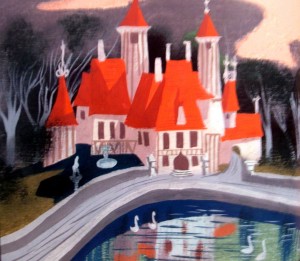 – On her site, Miscellainey, Lainey Schallock posts some of Mary Blair‘s Cinderella art from the newly published book. The book includes new text written by Newberry Medal winner, Cynthia Rylant.
– On her site, Miscellainey, Lainey Schallock posts some of Mary Blair‘s Cinderella art from the newly published book. The book includes new text written by Newberry Medal winner, Cynthia Rylant.
Lainey, on her post, writes an extensive and informed review of the book. She is a big fan of Mary Blair’s work, and has focused much of the blog’s attention on art of the period. Take the time to look back at some of the other, older posts if you’re not familiar with it. It’s quite a nice site.
(Click any image to enlarge.)
- Cartoonist/illustrator, Ed Sorel, wrote a beautiful piece about George Herriman and Krazy Kat for American Heritage Magazine back in 1982. You can read it on-line at their website, and, if you love Krazy Kat and have five minutes it’s worth the read.

And if you’re really a Herriman fan, Alan Holtz, on his site Stripper’s Guide, has been posting Herriman’s non-Krazy Political cartoons. They were published in the LA Examiner in the early 1900′s. Every Saturday, you can sign in for another great cartoon or three. Check it out, and thank you, Alan Holtz.
- Rachelle Bowden posts some beautifully artful photos of Wrigley Field and the Chicago Cubs baseball game on Labor Day. That’s the game where Carlos Zambrano
 attacked the fans verbally for booing him as he left the pitcher’s mound losing the game.
attacked the fans verbally for booing him as he left the pitcher’s mound losing the game.
If you go to Rachelle’s site, check out the photo of her Birthday Flowers on Sept 7th. She’s a first rate photographer.
I love her annual post of the flowers she receives from her parents on her birthday. It makes for a great series; I’ve followed and enjoyed this string for years.
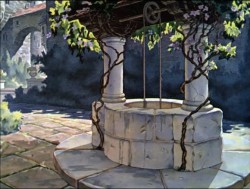 - Yet again, let me point you in the direction of Hans Bacher‘s excellent site, Animation Treasures 2. This site is a must see daily for all the stunning artwork Hans is posting from the backgrounds he’s reconstructing for us.
- Yet again, let me point you in the direction of Hans Bacher‘s excellent site, Animation Treasures 2. This site is a must see daily for all the stunning artwork Hans is posting from the backgrounds he’s reconstructing for us.____
His recent posts of the artwork from Snow White is just glorious. Such masterful watercolors. What an excellent film. I think I’ve gone back to his site half a dozen times, just to look. As a matter of fact I hope to make time to look at the film again, today.
- Finally, may I suggest you visit Bruce Watkinson‘s site, Understanding Animation. There he has an extensive and elaborate commentary on the life and work of disney legend, Ub Iwerks.
When I was a kid, my hero was Iwerks – (am I repeating myself?) The first short I bought to watch in my 8mm projector was Sinbad the Sailor. I studied that film frame by frame, backwards and forwards. I got the chance to talk with Grim Natwick when I learned that he probably had more to do with the film than Iwerks, himself.
I’m always excited by anything written about the man. His bio, The Hand Behind the Mouse, by John Kenworthy is one I’m pleased to own (though I wish there were another voice or two on the subject). Anything, on the subject is valuable to me. Hence, I was pleased to see and read Bruce’s piece, this morning. Check it out.
Daily post &Mary Blair 02 Jul 2007 08:22 am
Mary Blair, Rats &
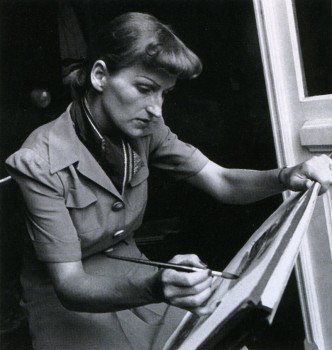 - Fred Cline has an interesting and informative reminiscence of Mary Blair on his blog. This entry is a letter Fred wrote to John Canemaker who was researching his book on Mary Blair. The letter talks about Fred’s first meeting with the Blairs and continues on through to her death and funeral.
- Fred Cline has an interesting and informative reminiscence of Mary Blair on his blog. This entry is a letter Fred wrote to John Canemaker who was researching his book on Mary Blair. The letter talks about Fred’s first meeting with the Blairs and continues on through to her death and funeral.
John’s book The Art and Flair of Mary Blair is the last word on this brilliant artist. (The photo to the left comes from the book. It shows Ms. Blair painting in South America in 1941.)
Fred World is developing into an excellent blog, so I’d suggest you keep atuned to it.
(Click any image to enlarge.)
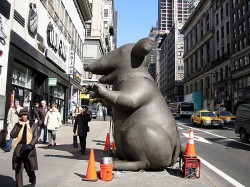 Ratatouille had a successful opening in the US. Just not as successful as Disney/Pixar might have hoped for. It opened on Friday with a $16.6 million opening to lead the box office (including the new Bruce Willis Die Hard movie). The important first weekend comes in at $47.2 million. That’s a bit lower than analysts had predicted. Unfortunately, this doesn’t equal the opening weekend of ANY other PIXAR film, and it’s likely to end up being one of their lowest grossing films. Thus it stands up to last week’s commentary from Jim Hill and Michael Barrier (see Two Days Away). the PixaRatatouille takes Manhattan.
Ratatouille had a successful opening in the US. Just not as successful as Disney/Pixar might have hoped for. It opened on Friday with a $16.6 million opening to lead the box office (including the new Bruce Willis Die Hard movie). The important first weekend comes in at $47.2 million. That’s a bit lower than analysts had predicted. Unfortunately, this doesn’t equal the opening weekend of ANY other PIXAR film, and it’s likely to end up being one of their lowest grossing films. Thus it stands up to last week’s commentary from Jim Hill and Michael Barrier (see Two Days Away). the PixaRatatouille takes Manhattan.
Jim Hillcontinues the conversation today about the prospects
for the box office suggesting it’s still too soon to write things off. Indeed.
Personally, I think to some extent all this is irrelevant. Brad Bird has pulled off an amazing feat. Technically this is the greatest achievement of
the Pixar films. The animation is the finest, the technology is top notch, the design is excellent. I encourage you to see it as long as you don’t squirm at the sight of dozens of rats running around kitchens. Brad Bird deserves all the congratulations he’s been garnering regardless of the grosses (which are still high and make the film a financial success). It’s an enormous achievement he’s pulled off.
By the way you can follow a complete week by week comparative breakdown of Ratatouille against all of the other Pixar films here.
I very much like that this film has generated such positive commentary about animation from within and outside the community. Reviewers nhave written some of their best on this animated film. A.O. Scott‘s review in last Friday’s NYTimes is a good example. (The Times also has an audio slide show with an interview with Brad Bird.) Many of the blogs are lighting up with positive comments. Michael Barrier led the way after he’d seen a preview. He also continues with additional comments. Jenny Lerew at Blackwing Diaries writes an excellent piece giving us a nice view of LA studios. There are many others from Cartoon Brew to Will Finn.
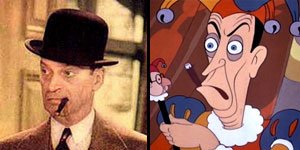 On a completely different note, Larry T. on his blog, Random Semiconscious Musings, has a great post on Mother Goose Goes Hollywood wherein he identifies all of the caricatures with matching photographs. It’s great to see the likes of Ned Sparks (pictured), George Arliss and Joe Penner.
On a completely different note, Larry T. on his blog, Random Semiconscious Musings, has a great post on Mother Goose Goes Hollywood wherein he identifies all of the caricatures with matching photographs. It’s great to see the likes of Ned Sparks (pictured), George Arliss and Joe Penner.
Thanks, Larry.
Books &Mary Blair 26 Jun 2007 08:22 am
Retta Scott & Cinderella II
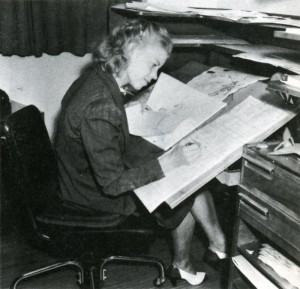 – Here are the remainder of the selections from Retta Scott’s illustrated version of Disney’s Cinderella.
– Here are the remainder of the selections from Retta Scott’s illustrated version of Disney’s Cinderella.
I’m actually curious to know how Western Publishing proceeded with the illustrated Disney books. Apparently a large number of Disney artists contributed to the books – at least in the 40′s & 50′s. Bill Justice, Dick Kelsey, Mary Blair, et al. Then, of course, there are the Golden Books that didn’t have a Disney connection by Disney artists. The Poky Little Puppy by Gustaf Tenggren is, of course, the most famous of these.
(Retta Scott working on Pastoral seq. from Fantasia.
From The Art of Walt Disney by Finch.)
I believe these original illustrations are still on exhibition at the Disneyland Gallery along with others gems from the Little Golden Book series illustrated by Disney artists.
There’s also a new Cinderella book available which uses preproduction art by Mary Blair. This one is NOT a Little Golden Book but comes from Disney Publishing.
Here’s the link to yesterday’s Part I posting, and
some of the remaining illustrations in this book follow:
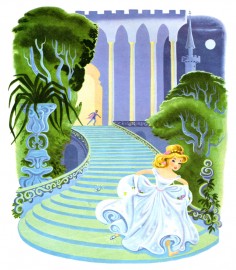 8
8 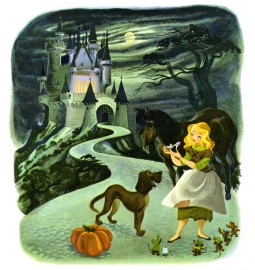 9
9
(Click on any image to enlarge.)
Books &Mary Blair 25 Jun 2007 07:30 am
Retta Scott & Cinderella I
– Retta Scott‘s name was always an intriguing one for me.
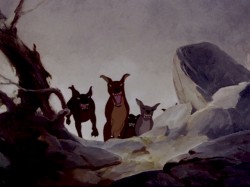 She was an animator on Bambi, Dumbo and Plague Dogs. She was layed off at Disney’s when they hit a slump in 1941 but came back to do a number of Little Golden Books for Disney. The most famous of her books was her version of Cinderella, one which was so successful that it remains in print today as a Little Golden Book.
She was an animator on Bambi, Dumbo and Plague Dogs. She was layed off at Disney’s when they hit a slump in 1941 but came back to do a number of Little Golden Books for Disney. The most famous of her books was her version of Cinderella, one which was so successful that it remains in print today as a Little Golden Book.
When asked why females weren’t animators at the studio, the Nine Old Men who traveled the circuit, back in the 1970′s, often mentioned her. They usually also said that she was one of the most forceful artists at the studio, but her timing always needed some help (meaning from a man.)
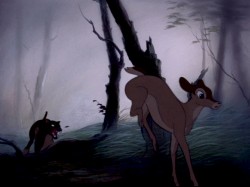 Ms. Scott was known predominantly for her animation in Bambi. Specifically, she’s credited with the sequence where the hunter’s dogs chase Faline to the cliff wall and Bambi is forced to fight them off.
Ms. Scott was known predominantly for her animation in Bambi. Specifically, she’s credited with the sequence where the hunter’s dogs chase Faline to the cliff wall and Bambi is forced to fight them off.
The scene is beautifully staged and, indeed, is forceful in its violent, yet smooth, movement. I was a young student of animation, so this sequence had a long and lasting impression on me.
.
Here are some of her illustrations for Cinderella published in 1950 to tie in with the Disney film. Oddly, the illustrations don’t completely look like the film’s characters. The cat and mice are close, but Cinderella, herself, is very different, less realistic. She looks more like a Mary Blair creation. When I was young, I was convinced that these were preproduction illustrations done for the film. If only.
To do justice to this book, though I’m not posting ALL of the illustrations, I’ll break it into two postings.
Books &Mary Blair 10 Apr 2007 08:12 am
Animation History Books
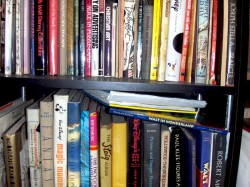 – In a letter from a friend, I was asked to recommend some animation books. That’s always a hard thing to do. Hard because I like things about books that aren’t necessarily things others like or are searching for. Hard because reading, to me, is such an individual preference that I know my likes aren’t going to please most others. And hard because so many books are written by friends whose work I admire – making me feel guilty (for no good reason) for recommending them – as if it were a bias on my part just because they’re friends. It’s particularly hard these days because there are so many good books coming out every day, and there are just too many books to point out. For that reason, I’m going to talk primarily about books I love – regardless of their availability.
– In a letter from a friend, I was asked to recommend some animation books. That’s always a hard thing to do. Hard because I like things about books that aren’t necessarily things others like or are searching for. Hard because reading, to me, is such an individual preference that I know my likes aren’t going to please most others. And hard because so many books are written by friends whose work I admire – making me feel guilty (for no good reason) for recommending them – as if it were a bias on my part just because they’re friends. It’s particularly hard these days because there are so many good books coming out every day, and there are just too many books to point out. For that reason, I’m going to talk primarily about books I love – regardless of their availability.
Saying all that, I also have to say that I’ve been thinking about such a post (or two) for a while, and I didn’t need too much encouragement. I love books. My studio is overrun with them; my apartment is overrun with them. Bookshelves are overstuffed, floors have piles on top of piles. I spent many years as a child in libraries going through art, animation and illustration books, lusting after so many of them. When I grew old enough to afford any, I started buying. So these are some of the books I love.
My all time favorite animation books include two impossible to get
classics:
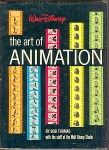 Bob Thomas‘ The Art of Animation. I’m only talking about the 1959 version, the one that promotes Sleeping Beauty, not the reworked versions they did for later features. I think I favor this book so much because it was the first big-deal animation book I ever owned (and read till the book just about fell apart.) The book gives a good overview of animation’s processes and methods and gives a sense of history to the subject. I learned so much from this book that I can’t properly evaluate it. I also may have read a lot inbetween the lines, but I got a lot out of it. Unfortunately, this book is out of print and is hard to find though I recently bought another copy of this book on ebay.
Bob Thomas‘ The Art of Animation. I’m only talking about the 1959 version, the one that promotes Sleeping Beauty, not the reworked versions they did for later features. I think I favor this book so much because it was the first big-deal animation book I ever owned (and read till the book just about fell apart.) The book gives a good overview of animation’s processes and methods and gives a sense of history to the subject. I learned so much from this book that I can’t properly evaluate it. I also may have read a lot inbetween the lines, but I got a lot out of it. Unfortunately, this book is out of print and is hard to find though I recently bought another copy of this book on ebay.
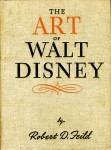 Robert Feild’s The Art of Walt Disney was an historical oddity that my local library had when I was young. It was published in the arly 40s and illustrates, in a somewhat formal way, the art of Disney’s early classic features. No artists are identified, no credit is given to anyone other than Disney.
Robert Feild’s The Art of Walt Disney was an historical oddity that my local library had when I was young. It was published in the arly 40s and illustrates, in a somewhat formal way, the art of Disney’s early classic features. No artists are identified, no credit is given to anyone other than Disney.
However, the book was so much a part of my childhood that I cherished it and was so proud when I finally was able to afford a rare copy I found at a used book seller back in the 60s. Elelments of animation that didn’t appear in the Thomas book were here: real art direction roughs, real animation roughs. Oddly both books feature sections on storyboards that were eliminated. I love them both.
Now to books that are more readily available – especially on-line – that I relish more for the material within than the nostalgia factor. However, just as I was significantly influenced by the above two books, I suspect the following are affecting new generations of animators:
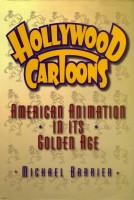 Mike Barrier‘s Hollywood Cartoons: American Animation in Its Golden Age is for animation fans as well as history buffs. Barrier is an articulate, knowledgeable, well-researched author who puts everything he has into his writing. He backs up his research with a monstrous collection of interviews with all the greats he writes about. His books aren’t big coffeetable tomes stuffed with great images; he writes about artists, animators and studios in a sophisticated way unearthing bits of history that add up to a sharp and dynamic picture of everyone or every film he focuses on.
Mike Barrier‘s Hollywood Cartoons: American Animation in Its Golden Age is for animation fans as well as history buffs. Barrier is an articulate, knowledgeable, well-researched author who puts everything he has into his writing. He backs up his research with a monstrous collection of interviews with all the greats he writes about. His books aren’t big coffeetable tomes stuffed with great images; he writes about artists, animators and studios in a sophisticated way unearthing bits of history that add up to a sharp and dynamic picture of everyone or every film he focuses on.
In a year, when I was despondent over the state of animation – particularly the work going (or not going) through my studio, this book is the only thing that kept me inspired and hopeful about animation and its possibilities. But that’s a very personal thing, and I make no bones about it. I’ve reread this book sevaral times and will do again. There’s just so much in it. 
Michael Barrier has also just seen his new book, The Animated Man, A Life of Walt Disney, released. I won’t review it here since I’ve just started reading it, but I’m totally hooked only fifty pages into it. I didn’t like the recent biography by Neal Gabler (I couldn’t get through it), but this is totally engrossing. I’ve read Disney’s life story what seems a million times over, so I’m amazed at how captivated I am.
When I’ve finished reading I’ll have more to say about it, but don’t wait for me. If you like Disney, like accurate history, like animation and want a good read, buy it.
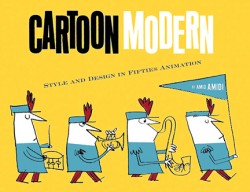 Amid Amidi has contributed a completely original title to the compendium of animation history with his book, Cartoon Modern: Style and Design in 1950s Animation. This is one of the finest art books with a focus on animation. It’s a treasure of glorious illustrations of hard to find films (never mind the actual artwork from the films) from the 50s and early 60s, with the analysis on the design in the films. Since these films were more about their design than their animation, this makes perfect sense. The organization within the book is a bit peculiar, but that’s expected given the numerous designers and studios involved. It’s become one of my treasures since its publication last year.
Amid Amidi has contributed a completely original title to the compendium of animation history with his book, Cartoon Modern: Style and Design in 1950s Animation. This is one of the finest art books with a focus on animation. It’s a treasure of glorious illustrations of hard to find films (never mind the actual artwork from the films) from the 50s and early 60s, with the analysis on the design in the films. Since these films were more about their design than their animation, this makes perfect sense. The organization within the book is a bit peculiar, but that’s expected given the numerous designers and studios involved. It’s become one of my treasures since its publication last year.
Animation inspires heavy duty coffee table books. John Canemaker is the king of beautiful books filled with excellent artwork telling the stories about the world of animation. John’s books are the closest to the classics I found as a child, the Thomas and Feild books, and I can only guess at how many kids were turned onto animation because of his writing.
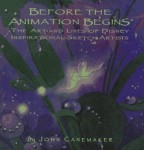 His Disney classics include: Walt Disney’s Nine Old Men (the story of the nine principal animators that Disney liked to focus on during the 50′s) and Paper Dreams: The Art and Artists of Disney Storyboards and The Art and Flair of Mary Blair (a focus on one specific Disney designer.) These are all filled with choice illustrations that are hard to find elsewhere (even on the internet) and lots of specific information that is informed and key to the history of Disney’s greatest films. My particular favorite among the books is relative to my specific interest in animation: design. The book, Before The Animation Begins, tells the story of Disney’s inspirational art directors and designers. It’s a beauty; well conceived, written, and designed.
His Disney classics include: Walt Disney’s Nine Old Men (the story of the nine principal animators that Disney liked to focus on during the 50′s) and Paper Dreams: The Art and Artists of Disney Storyboards and The Art and Flair of Mary Blair (a focus on one specific Disney designer.) These are all filled with choice illustrations that are hard to find elsewhere (even on the internet) and lots of specific information that is informed and key to the history of Disney’s greatest films. My particular favorite among the books is relative to my specific interest in animation: design. The book, Before The Animation Begins, tells the story of Disney’s inspirational art directors and designers. It’s a beauty; well conceived, written, and designed.
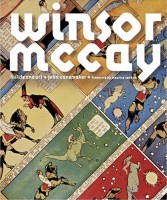 John Canemaker has non-Disney books as well. Two of them classic treasures among animation books. Winsor McCay : His Life and Art is the only significant book to put such a fine-tuned focus on animation’s first, great artist. There’s a wealth of material in this book with stunningly valuable illustrations. McCay deserved nothing less than the brilliance he put into his films, and Canemaker delivers.
John Canemaker has non-Disney books as well. Two of them classic treasures among animation books. Winsor McCay : His Life and Art is the only significant book to put such a fine-tuned focus on animation’s first, great artist. There’s a wealth of material in this book with stunningly valuable illustrations. McCay deserved nothing less than the brilliance he put into his films, and Canemaker delivers.
In Felix: The Twisted Tale of the World’s Most Famous Cat John gives the proper attention to the brilliant cartoonist Otto Messmer who did the hard work of supervising and drawing Felix to stardom. This is animation’s first big star, and the book shows you why.
I’ll post some favorite non-history/historical books later this week.
Commentary &Daily post &Mary Blair 27 Mar 2007 07:54 am
Song of the South links, etc.
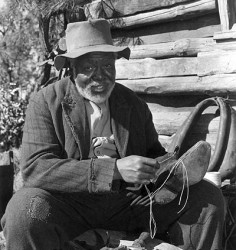 – USA Today has an article about Song of the South and the difficulties they seem to be having in releasing a dvd of the film. Isn’t it a little pathetic that the Disney execs have to squirm this much over the release of this film? Yes, we appreciate the political-correctness scares them, but is this film any worse than Gone With the Wind?
– USA Today has an article about Song of the South and the difficulties they seem to be having in releasing a dvd of the film. Isn’t it a little pathetic that the Disney execs have to squirm this much over the release of this film? Yes, we appreciate the political-correctness scares them, but is this film any worse than Gone With the Wind?
Isn’t it time the Disney folk gave James Baskett his due? He was the first African-American male to be given an Oscar (albeit a special award; he wasn’t put in competition). Baskett and Ethel Waters (who won Best Supporting Actress for Pinky that year) didn’t sit among the other stars, but were placed to the rear during the ceremony. Isn’t that the same thing Disney is doing, now using their fear of political correctness?
To this day his is still probably the best performance by an actor working with animated characters. There were significantly more restrictions on the actors then than there were at the time of Roger Rabbit, or anything more current (and controlled by computer aids.) It was all in his acting. The focus in his eyes tells you this man sees those characters, and they became real for us. Check out the Zip-A-Dee-Doo-Dah segment and look at his eyes. It’s outstanding.
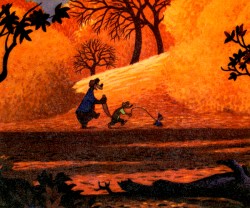 Read the Drafts for the film’s animation on Michael Barrier‘s site.
Read the Drafts for the film’s animation on Michael Barrier‘s site.
See some Mary Blair paintings done for this film on Amid Amidi‘s Cartoon Modern.
There’s a highly stylized Nash auto ad from the ’50′s on YouTube (in case you haven’t seen it) starring the three main characters from Song of the South.
Watch the Zip-A-Dee-Doo-Dah segment courtesy of Thad Komorowski.
The Asifa-Hollywood Animation Archive has some nice illustrations by Al Dempster and Bill Justice for a Little Golden Book version of the film.
 – Tom Sito had a nice little note on his blog today:
– Tom Sito had a nice little note on his blog today:
1952-U.P.A.’s cartoon Rooty-Toot-Toot premiered. Its music score was by jazzman Phil Moore, the first African American to receive a screen credit for scoring a movie.
Congratulations to SVA school grad, Dony Permedi for having won YouTube’s first ever award for the “Most Adorable” piece on the internet. His Kiwi was a Master’s thesis at SVA and has received over 6.5 million hits on the site. If you haven’t seen the Maya created video, check it out.
Stop Mo Expo – On Sunday, April 21st ASIFA Hollywood is presenting a day of celebration of 3D puppet animation. There will be all day seminars and conferences (from 9am to 5pm), as well as a number of screenings (from 6pm to 10pm). Filmmakers represented include: Will Vinton, the Chiodo brothers, Mark Caballero, Corky Quackenbush, and Seamus Walsh among others.
It will take place at Woodbury University, 7500 Glenoaks Blvd. Burbank, CA.
Vintage ToonCast is an entertaining site that includes a lot of public domain animated shorts such as Mel-O-Toons, Fleischer Superman,k Betty Boop and Popeye shorts, Daffy and the Dinosaur, A is for Atom (the John Sutherland film not the Disney “Our Friend the Atom”) and a lot more.
Animation &Mary Blair 25 Nov 2006 08:37 am
Mastercard Sherbet
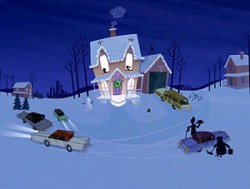 – An animated commercial, Mastercard – Full House was introduced last year during the holiday season. It’s making it back this year in a slightly larger way. I noticed this spot had been revived when it first started airing before Thanksgiving.
– An animated commercial, Mastercard – Full House was introduced last year during the holiday season. It’s making it back this year in a slightly larger way. I noticed this spot had been revived when it first started airing before Thanksgiving.
The ad was produced in England for McCann Erickson by the production house, Sherbet, a company set up in 1996 by producer, Jonathan Barstow, and director, Jonathan Hodgson. The company has won many international film awards including a BAFTA for best animation in 2000 for Hodgson’s short film, The Man With The Beautiful Eyes. Billy Crudup does the VO for the spot which AdWeek awarded with a “Spot of the Month.”
Go here to see the animated ad.
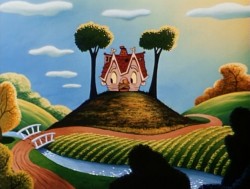 The spot originally caught my eye last year because it feels so much like the Disney short, The Little House, very much a product of Mary Blair’s design.
The spot originally caught my eye last year because it feels so much like the Disney short, The Little House, very much a product of Mary Blair’s design.
Amid Amidi wrote about it on his Cartoon Brew site and that led to the Sherbet site.
To me, the color design of this commercial doesn’t feel at all like Mary Blair’s work, although the film obviously was an influence. The charm of the spot is in the very modern approach taken while giving a retro nod to the classic short.
The director and designer of the spot was Sarah Roper, and the Animation Director was Robin Shaw. The Sherbet site gives only this information about Ms. Roper:
Sarah’s work is characterized by her elegant use of collage. She creates charming and appealing characters and has a great feeling for shape, texture and color. Her short film The Apartment Cat and her United Airlines commercial Legs use body language and facial expression to tell warm and witty stories.
She studied animation at the Royal College of Art. There, she worked with a personal technique using rubber stamps. In 1993, she won the MTV Free Your Mind competition. She did other shorts including Chicken Wire and animated for Astley Baker Davies on 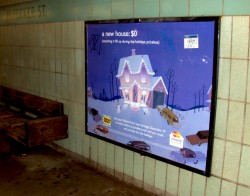 Peppa Pig and on Mark Baker’s The Jolly Roger, prior to joining Sherbet.
Peppa Pig and on Mark Baker’s The Jolly Roger, prior to joining Sherbet.
The commercial has made a comeback of sorts. It’s not only on television, but the campaign has grown to signage about town. Posters featuring an image from the ad are in the NYC subway system (it’s hard to find one that doesn’t have graffiti or a sticker pasted onto it.) I have to assume that they’re not only advertising in NYC, but that posters appear elsewhere. High honors for an animated spot.
(Click on any image to enlarge.)
Books &Festivals &Mary Blair 19 May 2006 06:26 am
Cannes & Walt’s People
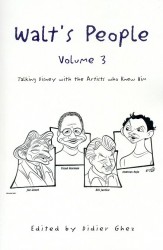 - In case you haven’t heard of Didier Ghez‘ three volume set of interviews published as Walt’s People Vols.1 & 2 and, just released, Vol. 3, you should look into it.
- In case you haven’t heard of Didier Ghez‘ three volume set of interviews published as Walt’s People Vols.1 & 2 and, just released, Vol. 3, you should look into it.
The books give a number of excellent in depth interviews with different artists who’ve worked with Walt Disney over the course of his career. They’re a wonderful tool for anyone interested in animation history and a good read for anyone interested in animation.
The most recent volume #3 includes interviews with: James Algar, Lee Blair, Joe Grant, Ben Sharpsteen, Bill Justice, Volus Jones, Ward Kimball, Burny Mattinson, Floyd Norman, and Bill Peet.
The first book features interviews with: Rudy Ising, Dave Hand, Bill Tytla, Ken Anderson, Jack Hannah, John Hench, Marc Davis, and Milt Kahl.
The second book includes: Friz Freleng, Grim Natwick, Frank Tashlin, Ward Kimball, Floyd Gottfredson, Frank Thomas, Eric Larson, and Woolie Reitherman
If you go to the Xlibris site, the primary distributor, you can get a sample of the interviews conducted within each of the books.
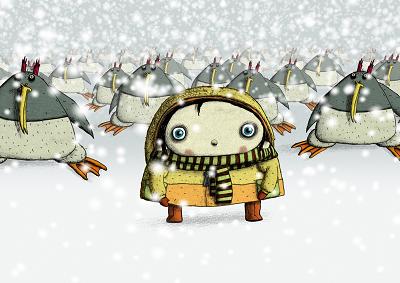 – The 2006 Cannes Film Festival, currently in progress, has only two animated shorts in competition this year. One French, one Swiss. They are:
– The 2006 Cannes Film Festival, currently in progress, has only two animated shorts in competition this year. One French, one Swiss. They are:
Icefloe is a Swiss animated film directed by Cédric LOUIS and Claude BARRAS.
The film tells the story of Marine, an obese young girl, who suffers from the heat of summer and the way other people look at her. She dreams of a better life among the penguins on an ice floe.
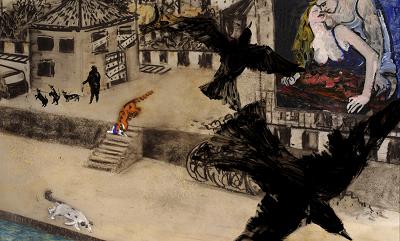 Conte De Quartier – A French film directed by Florence MIAILHE.
Conte De Quartier – A French film directed by Florence MIAILHE.
In a neighbourhood about to be torn down, construction wrecking ball in sight, seven characters cross paths. A rag doll with an inner secret is relayed from one character to another, creating a skein of tangled destinies inspired by tabloid news items.
Florence Miailhe used sand-and-oil-paint-on-glass animation and a digital camera to make the film. Technically it feels a bit like the style developed by Caroline Leaf in The Street.
You can see a sample of it here.
Neither film is listed in competition or Panorama at Annecy or Zagreb. Maybe Ottawa?
- Mark Mayerson has posted a fabulous letter by Dick Lundy, dated 1978, which gives a first person breakdown of his own career. It’s quite remarkable and an entertaining read.
